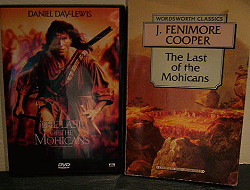
Photo. Covers of the movie and book The Last of the Mohicans. This movie was masterly re-created by director Michael Mann. From start to end there are stunning scenes, breathtaking landscapes and wonderful music. The last scene is in my opinion one of the most amazing in the history of movie making.
The novel The Last of the Mohican was first published in January 1826. The story takes place in 1757 during the Seven Years' War. This war is also known in America as the French and Indian War where France and Great Britain fought for getting control over the North American colonies.
During this war, the French often allied themselves with Native American tribes in order to gain an advantage over the British, with unpredictable and often tragic results.
This James Fennimore Cooper novel has been filmed about six times. This 1992 version has an impressing historical accuracy even the movie takes liberties with James Fenimore Cooper's story. Cora (Madeleine Stowe) and her younger sister, Alice (Jodhi May), both recent arrivals to the colonies, are being escorted to their father, Colonel Munro (Maurice Roeves), by a troop of British soldiers. Along the way they are ambushed by a Huron war party led by Magua (Wes Studi), a sinister warrior with a blood vendetta against Munro.
Hawkeye (Daniel Day-Lewis) is the big hero in the movie, a white trapper raised by the Mohican tribe.
The Last Of The Mohicans - Trailer – HQ
http://www.youtube.com/watch?v=JY9DukmDoHc
Photo. The Mohegan tribe is an Algonquian-speaking tribe that lives today in the eastern upper Thames valley of Connecticut in the US.
The Mohegan were originally a conjoined tribe with the Pequot until the period of European contact in the 17th century, briefly coming under Pequot rule in the 1630s until the dominant tribe was destroyed in 1637.
The Mohegan Reservation is located in Montville, New London County, in the southeastern corner of the U.S. state of Connecticut. As of 2000 the population was 259,088. Connecticut is a state in the New England region of the northeastern United States. It is bordered by Rhode Island to the east, Massachusetts to the north, and New York to the west and south (because various islands of New York span Connecticut's entire coast). And it`s not so far from the Canadian border.
The tribe gained federal recognition in 1994, and currently operates the Mohegan Sun Casino in Uncasville, Connecticut, as well as a casino at Pocono Downs, Wilkes-Barre, Pennsylvania.
The Mohegan Tribe is a sovereign, federally recognized Indian nation, with a reservation on the Thames River near Uncasville, Connecticut. The Mohegan Tribe received formal (federal) recognition in March 1994.
According to information from the Mohegan`s website, the tribe currently includes about 1,835 members. The Mohegan Tribe is governed by its Constitution, affirmed in April 1996. The nine-member Tribal Council has overall executive and legislative responsibilities not otherwise granted to the Council of Elders. Members serve four year, staggered terms.
The seven-member Council of Elders is responsible for judicial oversight and cultural integrity. Members serve four year, staggered terms.
The Mohegan Tribe exercises full civil jurisdiction and concurrent criminal jurisdiction over its reservation lands.
Scientific evidence shows Native American presence in the area for 10,000 years. Explore the history of the Mohegans on its website: www.mohegan.nsn.us
The Last of the Mohicans is widely read in American literature courses. This second book of the Leatherstocking Tales pentalogy is the best known. The Pathfinder, written 14 years later in 1840, is its sequel.
Cooper named a principal character Uncas after a real person. Uncas was a Mohegan, not a Mohican, and Cooper's usage has helped to confuse the names of two tribes to the present day.
When John Uncas, his last surviving male descendant, died in 1842, the Newark Daily Advertiser wrote "Last of the Mohegans Gone" leaded to the extinction of the tribe. The writer was not aware that Mohegans still existed then, as they do to the present day.
Coming up more stories, information and photos about the Huron Indians:
Are they so scary as they were depicted in the movie The Last of the Mohicans. I and my friend Geir met some Huron Indians outside Quebec in Canada for 15 years ago.
Stein Morten Lund, 23 January 2010
Additional information
The Mohegan Tribe
Office 5 Crow Hill Road
Uncasville, CT 06382
US
(860) 862-6100
Tantaquidgeon Museum
Open May through October
Wednesday - Saturday 10:00a.m. - 4:00p.m.
Groups over 8 by appointment
For more information call 860-848-0594 or email at museum@moheganmail.com
Annual Wigwam Festival
When: Dates in 2010: August 21-22, 10am - 7pm
Where: Shantok Village of Uncas
Admission: Free
Parking: Air conditioned shuttles
Activities: Indian art exhibits, competitive native dance exhibitions, native craft vendors, traditional native food vendors, old style Pow Wow drumming, contemporary native performers
The Mohegan Tribe is also connected to the Shawano County, which is a county located in the U.S. state of Wisconsin. As of 2000, the population was 40,664. Its county seat is Shawano.
Huron Indians:
Huron Indians were depicted as bloodthirsty and brutal in the book and movie The Last of the Mohicans. They were the Mohicans worst enemies. Huron Indians (properly, Wandot or Wyandot), confederacy of nomadic Iroquoian tribes, which originally inhabited Ontario, where Champlain visited them (1603). They were bitter enemies of the Iroquois proper, who almost destroyed them (1648–49). Some survivors fled to Quebec and descendants of others settled in Michigan and Ohio. They fought against the U.S. in the Revolution and the War of 1812, but later moved to Oklahoma. In the Leather‐Stocking Tales the Hurons are depicted as treacherous and cruel, and they figure also in Satanstoe.
Wendake, Village of the Huron-Wendat Nation:
"Kwe kwe", she said, the young and sweet Huron girl standing by the entrance. In her language it means welcome! She guided me and my friend around in the village. We also met some other Hurons who were definitely not so scary as the way the Huron Indians were depicted in the book and movie The Last of the Mohicans.
The Hurons originate from the Great Lakes area, the Wendat, called Hurons by the French explorers, migrated to the area of Quebec City near the middle of the 17th century. In 1697, they settled permanently in the place that is now known as Wendake, along the Saint-Charles River.
The re-creation of a Huron native village was an interesting cultural and historic experience for us. Today, Wendake is a tidy, bustling town that is home to about 1,500 people. The traditional Huron Site “ONHOÜA CHETEK8E”, is the most authentic recreation of a Québec Indian village. This site offers a unique opportunity to visitors to discover the history, the culture and the lifestyle of Hurons of the past and of today.
Here we could enter the Long House, Huron’s traditional housing, which gave a good presentation of the Huron’s way of life. As my friend Geir commented: it couldn`t been much private life for the Hurons in these houses.
Wendake is the current name for the Huron-Wendat reserve, an enclave within Quebec City, Quebec, Canada. This was formerly known as Village-des-Hurons, or "Huron Village", and also as (Jeune)-Lorette. The Huron-Wendat of Wendake (formerly called the Hurons of Lorette) originally came from the Georgian Bay region.
Website: http://www.wendake.ca/
Mario Gros-Louis, Owner and Founder
Nancy Picard, Director of Marketing
Contact information:
Telephone : 418-842-4308
Website: www.huron-wendat.qc.ca
Fax : 418-842-3473
wendat@huron-wendat.qc.ca
575, rue Stanislas-Kosca, Village-des-Hurons (Wendake),
Québec, Canada, G0A 4V0












